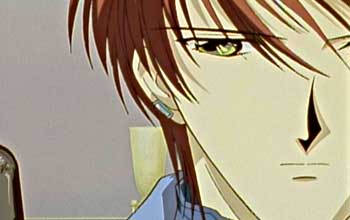
by Luis Reyes
|
"Moving the bad guys to the side, of all the good characters, I think there's a little of me in each one of them," she says, asked with which of her characters she most identifies. "I can't put a finger on any single character that's most like me." I then asked if she sees herself even in her villains, trying to draw out what could be a well-obscured darker side of Watase Yu. However, with aplomb and grace, she expounds on how "good" and "evil" are elusive concepts that may very well be two sides of the same coin.
"When I create bad characters, I think, 'what would I not do?' and then incorporate those traits into the characters. But most of my bad guy roles aren't truly completely bad; they're driven to bad behavior because of some kind of circumstance or some kind of sadness within them. When I have to write stories about them, it's hard for me to come up with, 'what is being evil?' Of course, you can come up with simple answers like 'dominate the world,' but other than that I have a hard time coming up with an answer to 'what's bad.'" If "good" and "evil" are then such blurry concepts, where does conflict arise in Watase Yu's stories? Again, an answer worthy of her status:
"The conflict in my stories, in many cases, involves both the good and evil characters striving for the same goal but differing only in how they choose to achieve that goal," she says. "The evil characters do it in a way counter to the way a normal person should act. The conflict comes from both sides trying to achieve their goals in their own way, and one side trying to prevent the other from succeeding." With a thorough grilling of her narrative process out of the way, we turn to discourse about the manga industry at large, for which - she once noted in an earlier Akadot interview - the boundaries between shoujo and shounen were eroding, elements of each slipping into the other. This phenomenon may stem from a circumstance that younger anime directors such as Kazuya Tsurumaki (FLCL) and Mahiro Maeda (Blue Submarine No. 6) have described as well.
"I'm a child of the animation age," Yu somewhat proudly proclaims. "I grew up watching girl's animation and I grew up watching boy's animation. I grew up watching robot shows. I grew up watching the magical girl shows. So from the beginning I've had a hybrid of both in me. When I started writing my stories, they just happened to first appear in a shoujo comic." She goes on to explain the prevalence in the manga industry of borrowing elements of style. Shounen manga, Yu says, have developed an affinity for very beautiful characters - a traditional trait of shoujo - and explore storylines that deal more with the psychology of a character rather than the stamina necessary to fight off a horde of assassins. On the flip side, shoujo manga have adopted the use of highly articulated fight scenes, which has attracted many a boy to shoujo stories such as Sailormoon.
|

